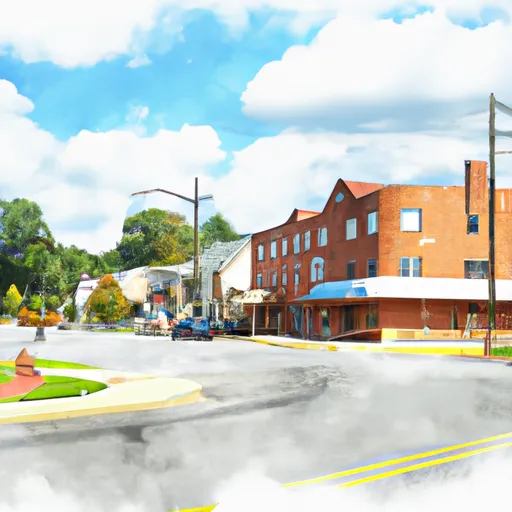-
 Snoflo Premium
Snoflo Premium
Get unlimited access to all our content
With no Ad interruptions! - Start Your Free Trial Login with existing account
Manorville
Eden Index
Climate
8.0
•
Recreation
3.1
•
Community
3.1
•
Safeguard
5.0/10

Manorville, Pennsylvania is a small borough located in Armstrong County, in the western part of the state. The town experiences a humid continental climate, characterized by hot summers and cold winters. Average temperatures range from around 20°F (-6°C) in winter to 85°F (29°C) in summer. Manorville receives an average annual precipitation of about 40 inches, with rainfall distributed evenly throughout the year.
The hydrology constituents in Manorville mainly comprise the Mahoning Creek, which flows through the borough. This creek provides opportunities for various outdoor activities like fishing, boating, and swimming. Anglers can catch a variety of fish species, including trout, bass, and catfish.
Manorville is surrounded by picturesque nature, offering several outdoor recreation opportunities. The nearby Crooked Creek Lake provides opportunities for boating, kayaking, and canoeing. The surrounding forests and trails are ideal for hiking, camping, and birdwatching. Nature enthusiasts can also explore the state parks and wildlife areas in the region, such as Allegheny River Islands State Park and Blue Spruce Park.
Overall, Manorville's climate, hydrology constituents, and outdoor recreation options make it an appealing destination for nature lovers and outdoor enthusiasts.
What is the Eden Index?
The Snoflo Eden Index serves as a comprehensive rating system for regions, evaluating their desirability through a holistic assessment of climate health, outdoor recreation opportunities, and natural disaster risk, acknowledging the profound impact of these factors on livability and well-being.
Climate Health Indicator (CHI): 8.0
Manorville receives approximately
1060mm of rain per year,
with humidity levels near 83%
and air temperatures averaging around
10°C.
Manorville has a plant hardyness factor of
6, meaning
plants and agriculture in this region thrive during a short period during spring and early summer. Most
plants will die off during the colder winter months.
By considering the ideal temperature range, reliable water supplies, clean air, and stable seasonal rain or snowpacks, the Climate Health Indicator (CHI) underscores the significance of a healthy climate as the foundation for quality living.
A healthy climate is paramount for ensuring a high quality of life and livability in a region, fostering both physical well-being and environmental harmony. This can be characterized by ideal temperatures, reliable access to water supplies, clean air, and consistent seasonal rain or snowpacks.
Weather Forecast
Streamflow Conditions
Allegheny
Area Rivers
Allegheny
Snowpack Depths
Allegheny
Reservoir Storage Capacity
Allegheny
Groundwater Levels
Recreational Opportunity Index (ROI): 3.1
The Recreational Opportunity Index (ROI) recognizes the value of outdoor recreational options, such as parks, hiking trails, camping sites, and fishing spots, while acknowledging that climate plays a pivotal role in ensuring the comfort and consistency of these experiences.
Access to outdoor recreational opportunities, encompassing activities such as parks, hiking, camping, and fishing, is crucial for overall well-being, and the climate plays a pivotal role in enabling and enhancing these experiences, ensuring that individuals can engage in nature-based activities comfortably and consistently.
Camping Areas
| Campground | Campsites | Reservations | Toilets | Showers | Elevation |
|---|---|---|---|---|---|
| Mill Run - Youghiogheny River Lake | None | 1,565 ft | |||
| Tub Run Rec Area - Youghiogheny River Lake | 101 | 1,583 ft | |||
| Bush | None | 957 ft | |||
| Keystone State Park | None | 1,079 ft | |||
| Kentuck - Ohiopyle State Park | 200 | 1,558 ft | |||
| Crooked Creek Recreation Area | None | 969 ft | |||
| Tionesta Rec Area - Tionesta Lake | None | 1,078 ft | |||
| Outflow - Youghiogheny River Lake | 63 | 1,329 ft |
Nearby Fishing
Nearby Ski Areas
Catastrophe Safeguard Index (CSI):
The Catastrophe Safeguard Index (CSI) recognizes that natural disaster risk, encompassing floods, fires, hurricanes, and tornadoes, can drastically affect safety and the overall appeal of an area.
The level of natural disaster risk in a region significantly affects safety and the overall livability, with climate change amplifying these risks by potentially increasing the frequency and intensity of events like floods, fires, hurricanes, and tornadoes, thereby posing substantial challenges to community resilience and well-being.
Community Resilience Indicator (CRI): 3.1
The Community Resilience Indicator (CRI) recognizes that education, healthcare, and socioeconomics are crucial to the well-being of a region. The CRI acknowledges the profound impact of these elements on residents' overall quality of life. By evaluating educational resources, healthcare accessibility, and economic inclusivity, the index captures the essential aspects that contribute to a thriving community, fostering resident satisfaction, equity, and social cohesion.

